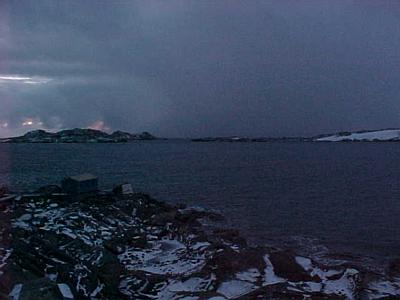
|
|
7 April, 2000
Palmer LTER
Question 48: How big is Antarctica?
Even with 25 knot winds blowing snow into our faces, Katrin and I went out to
dive today, valiantly accompanied by Bruce and Andy as tenders. Fortunately
our dive site at Litchfield was in the lee (protected from the wind) and we
actually had a very calm dive. Katrin and I have been doing shallow (8 - 25
feet) surveys of the organisms and environment around Litchfield Island. This
year the island's status as an ASPA (Antarctic Specially Protected Area,
formerly SSSI--Site of Special Scientific Interest) is being evaluated again,
and the shallow marine environment surrounding it has not previously been
included. The Office of Polar Programs asked our team to take a look. The
three survey areas have been spread around the island's perimeter and have
been done by the same divers so that estimates of abundance and depths are
consistent between the surveys.
There are Long Term Ecological Research project sites all over the world in
unique environments. The LTERs are ten-year projects, yielding many years of
data collection from one location, which is essential in order to make sound
ecosystem-level conclusions. A LTER project examines many components of the
environment's ecology and how they fit together. In Antarctica there are
LTERs in the McMurdo Dry Valleys and at Palmer. The Palmer LTER project's
central hypothesis is that the annual advance and retreat of sea ice is a
major physical determinant of spatial and temporal changes in the structure
and function of the Antarctic pelagic ecosystem. This field season, the
Palmer LTER involves six different components, each with a team working
specifically on that component. Some of the components are Seabirds,
Phytoplankton Ecology, Environmental Modeling, and Prey (plankton).
When I arrived at Palmer, the LTER groups had completed the ship-based work
they do from the Gould and the Palmer. The station-based project components
were finishing up (the LTER is here during the summer season) and only the
seabird, krill and phytoplankton groups were working within the Palmer
small-scale sampling area (basically the Zodiac boating limit). I was able to
accompany all three in the field and have already written about the field
experiences in previous journal entries--Donna Patterson's giant petrels and
the pelagic sampling boats, Bruiser and Lowrider.
The LTER project scientists think that annual changes in sea ice have a major
impact on all levels of the food web, from primary production (photosynthesis)
to the breeding success in the top level predators (such as leopard seals).
They believe it regulates the abundance and distribution of krill as well as
the survivorship of other predators (such as penguins). Ice extent might
affect prey and predators directly (access to open water or preferred
habitats) or indirectly (food availability). The magnitude (how much) and
timing (when it forms and retreats) of sea ice may have different consequences
for different species. For example, Adelie penguins appear to need lots of
krill for high levels of survivorship and breeding success. The availability
of krill is correlated with greater ice coverage, more krill with more ice.
In contrast, the survivorship and breeding success of skuas appears to be
determined by the availability of Antarctic silverfish. These are associated
with areas and years of lesser ice coverage.
To confirm their hypotheses, the LTER groups are trying to 1) document
annual variability in sea ice, 2) document the physics, chemistry, optics and
primary production that accompanies the sea ice changes, 3) document life
histories of secondary producers, predators and top predators in the area, 4)
identify and measure the processes that cause biological changes in the
various trophic levels, and 5) construct and test models that link ecosystem
processes to environmental variables (changing factors).
Answer 47: About 70% of the world's fresh water is contained in Antarctica's
icecap.

6 pm view of Marr Glacier across Arthur Harbor.

6 pm view of Arthur Harbor, Torgersen and Litchfield Islands.

8 am view of Arthur Harbor, Torgersen and Litchfield Islands.

Contact the TEA in the field at
.
If you cannot connect through your browser, copy the
TEA's e-mail address in the "To:" line of
your favorite e-mail package.
|
